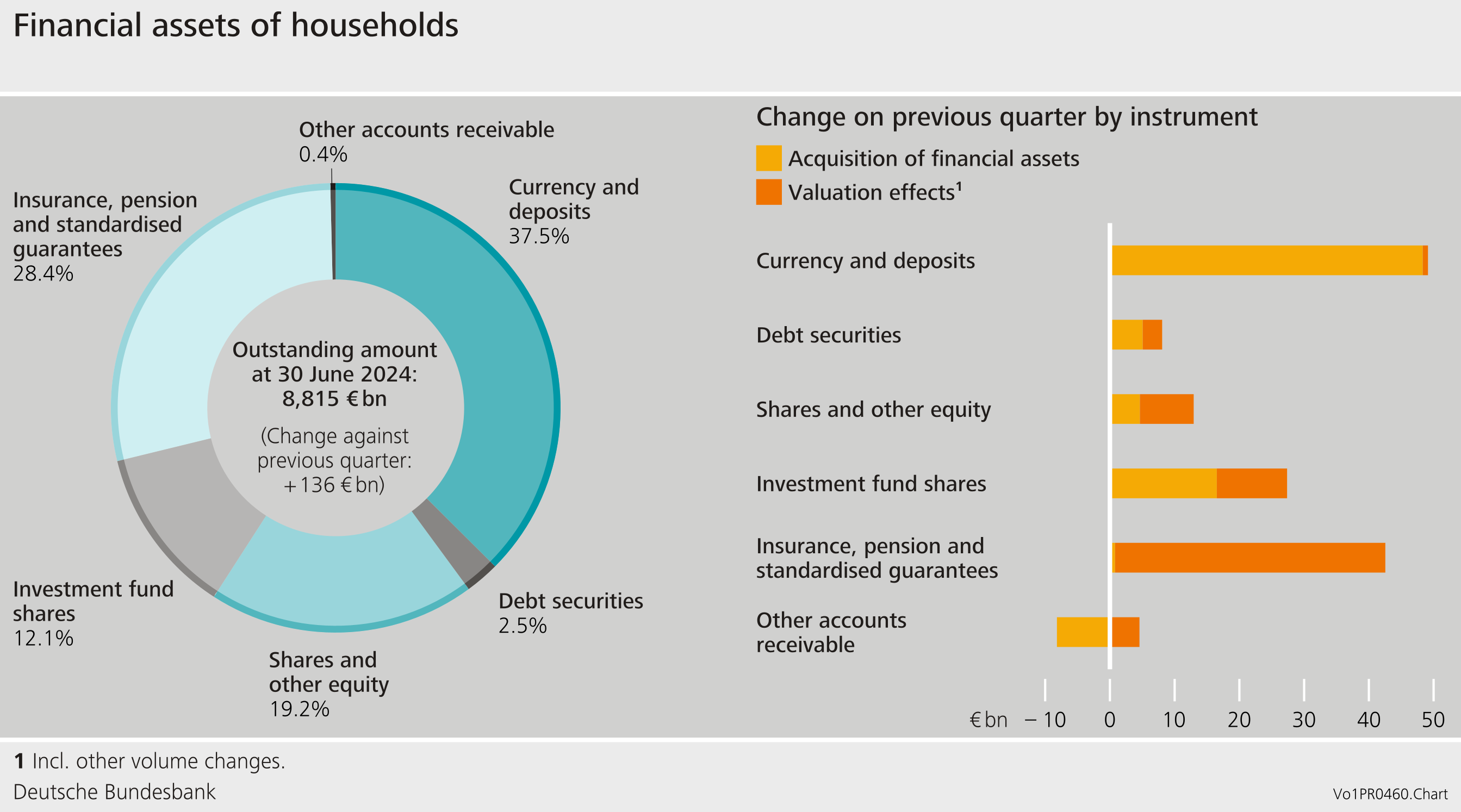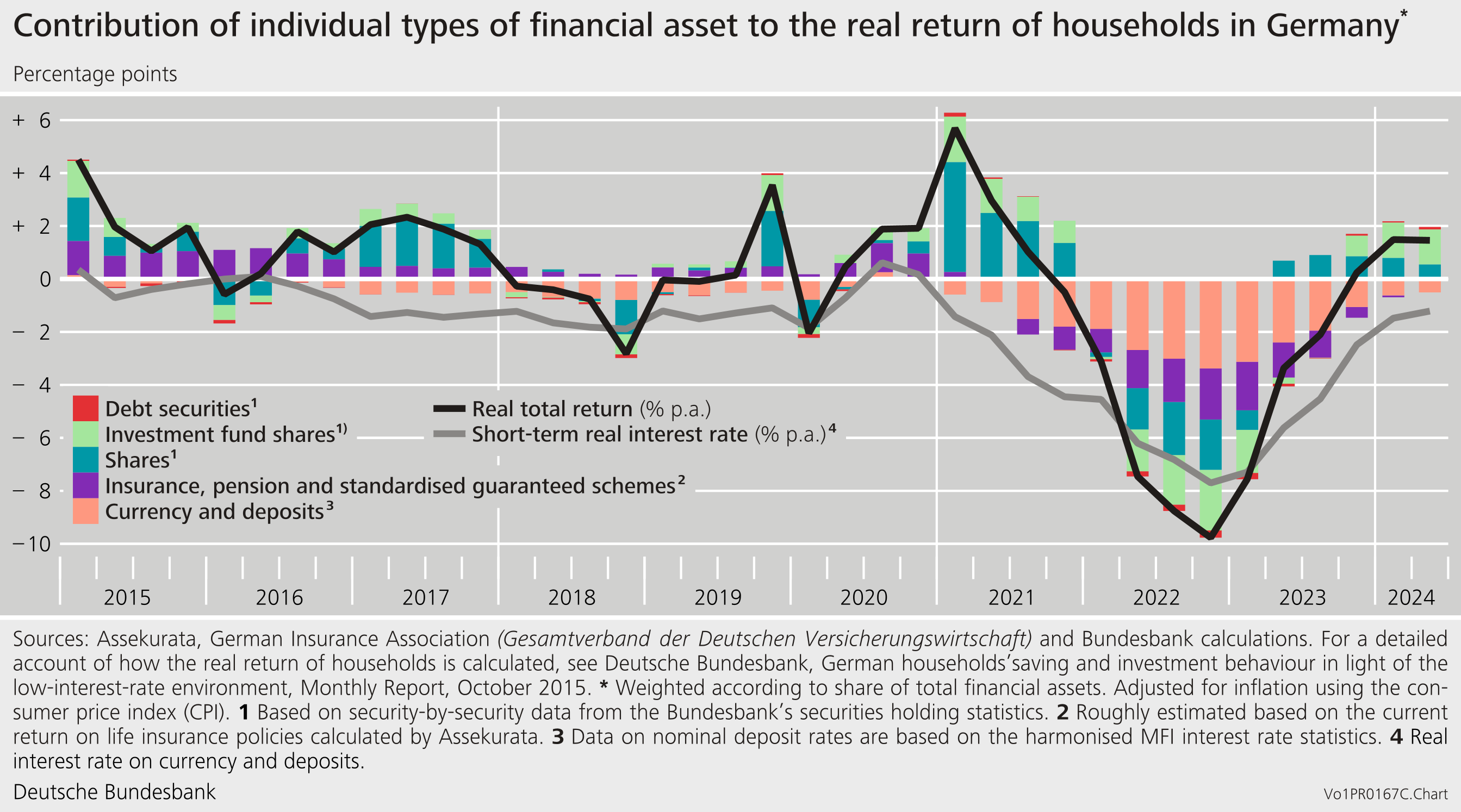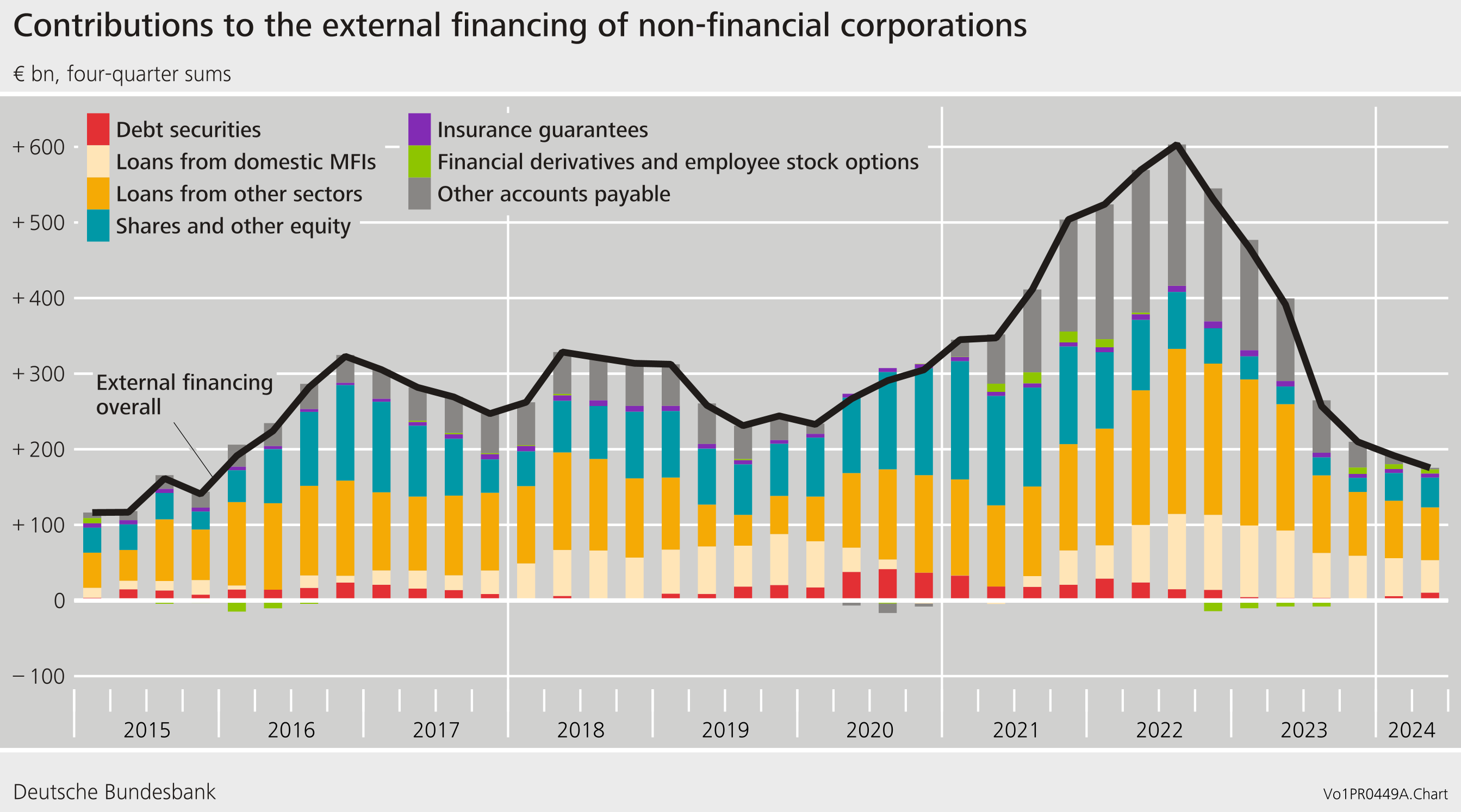Acquisition of financial assets and external financing in Germany in the second quarter of 2024 Results of the financial accounts by sector
- Households’ financial assets up by €136 billion.
- Households’ liabilities unchanged; debt ratio down.
- Firms’ external financing down to €47 billion.
- Results take into account methodological changes to the financial accounts due to the Europe-wide benchmark revision.
Households’ financial assets increased further in the second quarter of 2024
In the second quarter of 2024, German households’ financial assets grew by €136 billion, closing the quarter at €8,815 billion.[1] This represents a new all-time high. Following an unusually strong rise in claims in the previous quarter (€87 billion), households increased their claims by €67 billion in the reporting quarter, which brought them to the average of the last two years. Unlike in previous quarters, there was no shift on balance from low-interest sight deposits to higher-interest time deposits. Instead, households increased their holdings of currency and sight deposits by €12 billion. This is the first growth seen in these categories since the fourth quarter of 2022. Transactions in favour of time deposits weakened to €39 billion, compared with €60 billion in the previous quarter.
Households also purchased debt securities as well as shares and other equity, each in the value of €5 billion. As in previous quarters, listed shares of domestic issuers were sold (-€1 billion) and shares of foreign issuers were purchased (+€2 billion). There was a marked increase in investment fund shares, with households acquiring €17 billion of these on balance.
In the second quarter of 2024, households recorded valuation gains totalling €69 billion. Investment fund shares accounted for valuation gains of €11 billion. The picture was mixed for shares and other equity – while listed shares of domestic corporations faced valuation losses of €15 billion, listed shares of foreign issuers achieved valuation gains of €10 billion. A further €42 billion is attributable to valuation gains on insurance and pension claims.[2]
Real total return on financial assets unchanged
The real total return – i.e. adjusted for inflation – on households’ financial assets represents the actual return on financial assets for households based on the period-specific asset structure of financial assets. In the second quarter of 2024, the real total return stood at 1.5%, thus remaining virtually unchanged from the previous quarter. While shares in investment fund units, in particular, contributed positively to the real total return, the continued negative real return on currency and deposits had a dampening effect.
Households’ liabilities again unchanged
Households’ liabilities moved sideways in the second quarter of 2024, totalling €2,146 billion at the end of the quarter. As in the preceding quarters, the lack of growth in liabilities reflected the weak growth in loans for house purchase. The debt ratio fell by 0.5 percentage point to 50.4% due to the nominal increase in gross domestic product.[3]
According to the financial accounts, households’ net financial assets increased in total by €136 billion to €6,669 billion in the second quarter of 2024. With the Distributional Wealth Accounts (DWA), the Bundesbank provides additional data on the distribution of households’ wealth. These data show that wealth inequality is fairly high in Germany. According to the DWA, the wealthiest 10% of households hold more than 70% of net wealth, while the less wealthy half of all households hold just under 1% of net wealth.[4]
External financing of non-financial corporations down
Non-financial corporations’ external financing declined by €4 billion to €47 billion in the last quarter. On balance, borrowing amounted to €26 billion, compared with €33 billion in the previous quarter. Issuance of shares and other equity remained stable at €13 billion.
In annual terms, based on four-quarter moving sums, non-financial corporations’ external financing has declined since the third quarter of 2022.
At the end of the second quarter of 2024, non-financial corporations’ liabilities moved sideways, increasing very slightly by €3 billion to €11,424 billion[5]. Issued equity recorded losses in value (-€69 billion). Despite weaker external financing, loans rose to €3,676 billion. Here, there were positive valuation effects of €17 billion, which were largely attributable to exchange rate fluctuations in non-financial corporations’ external loans. Taken together, there was an increase in debt instruments relevant to the debt ratio, with a slight rise from 67.7% to 68.0%.[6]
The financial assets of non-financial corporations decreased by €45 billion, reaching €8,780 billion at the end of the quarter under review. Taken together, non-financial corporations’ net financial assets dropped to -€2,644 billion.
Owing to interim data revisions of the financial accounts and national accounts, the figures contained in this press release are not directly comparable with those shown in earlier press releases.
- As agreed at the European level, the benchmark revision of national accounts and balance of payments data took place in September 2024. This revision includes, on the one hand, fundamental methodological adjustments, but also corrections to individual business transactions. One of these adjustments, the consequences of which are visible in the figures in this press release, is the recalculation of unlisted shares and other equity (F.512 and F.519). The holdings and transactions (as well as valuation effects and other volume changes) of the sectors presented were revised in September 2024 for the years from 2016 onwards. The starting point for the new method is the annual individual financial statements according to the German Commercial Code (Handelsgesetzbuch or HGB). The issuance of unlisted shares and other equity is calculated on the basis of the equity position on the balance sheets of non-listed companies. A more detailed description of the method can be found in the new section entitled “Perspectives in financial accounts” on the financial accounts homepage.
- The methodology for calculating households’ technical provisions is based on the Solvency II reporting system, under which the discounted cash flow method is used to calculate/value these provisions: https://eur-lex.europa.eu/legal-content/EN/TXT/PDF/?uri=CELEX:02009L0138-20190113. The relevant interest rate structure for discounting technical provisions in Solvency II is determined by EIOPA on a monthly basis. At each valuation date, the provisions for all existing contracts must be valued at current interest rates. This form of market price valuation means that, under Solvency II, technical provisions are significantly influenced by the current interest rate environment. This means that individual quarters may exhibit stronger valuation effects.
- The debt ratio represents debt as a percentage of nominal gross domestic product (four-quarter moving sum).
- In the DWA, net wealth comprises the following types of assets and liabilities: deposits, debt securities, listed shares, investment fund shares, insurance claims (life insurance and private retirement provision), financial business wealth, and liabilities in the form of loans for house purchase and other debt. Net wealth is ultimately calculated as the difference between the total aforementioned assets and liabilities. For more information on the DWA, see also https://www.bundesbank.de/en/press/press-releases/bundesbank-releases-distributional-wealth-accounts-for-households-in-germany-921302
- See footnote 1.
- The debt ratio is calculated as the sum of loans, debt securities and pension provisions as a percentage of nominal gross domestic product (four-quarter moving sum). For loans, a partial consolidation is carried out by deducting intra-sector claims/liabilities.
The data on the financial accounts are available at


